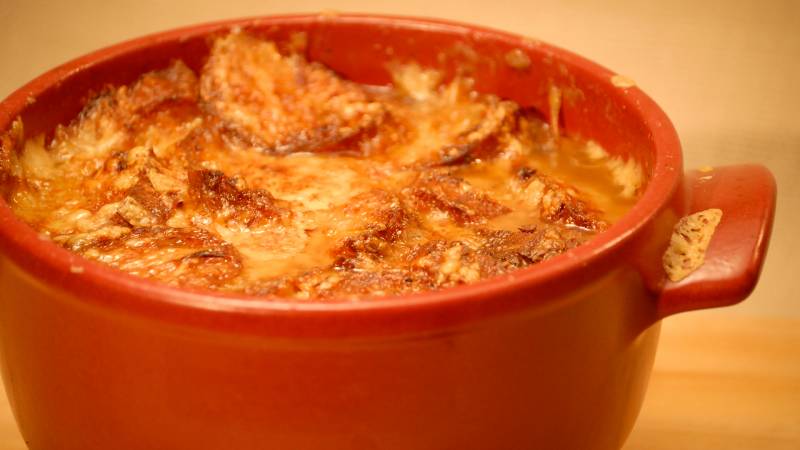Arrange the bread slices on a cookie sheet and bake for 8 to 10 minutes, until browned. Remove from the oven and set aside. (Leave the oven on.) Melt the butter in a large saucepan. Add the onions and sauté for 15 minutes, or until dark brown.
Add the stock, salt, and pepper. Bring to a boil and cook for 20 minutes. Push the soup through a food mill.
Arrange one third of the toasted bread in the bottom of an ovenproof soup tureen or large casserole. Sprinkle with some of the cheese, then add the remaining bread and more cheese, saving enough to sprinkle over the top of the soup. Fill the tureen with the hot soup, sprinkle the reserved cheese on top, and place on a cookie sheet. Bake for approximately 35 minutes, or until a golden crust forms on top.
At serving time, bring the soup to the table. Combine the yolks with the port in a deep soup plate and whip with a fork. With a ladle, make a hole in the top of the gratinée, pour in the wine mixture, and fold into the soup with the ladle. Stir everything together and serve.
CHICKEN STOCK
Makes 3 quarts
It takes very little work to make your own stock; mostly it is a matter of being at home for the several hours it takes to cook. A flavorful money saver that is practically fat- and salt-free, homemade stock can be frozen in small quantities and used as needed.
Chicken backs and necks are available at most supermarkets. If you don’t see them, ask the butcher to set aside some for you. I also make stock from the bones of roasted chicken or turkey.
4 pounds chicken bones (necks, backs, wings, etc.), skinless or with as little skin as possible
6 quarts cold water
1 large onion (about 8 ounces), quartered
1 tablespoon herbes de Provence
12 whole cloves
4 bay leaves
1 tablespoon dark soy sauce (optional)
Combine the bones and water in a large stockpot and bring to a boil over high heat. Reduce the heat and boil gently for 30 minutes. Most of the fat and impurities will rise to the surface; skim off as much of them as you can and discard them.
Add the onion, herbes de Provence, cloves, bay leaves, and soy sauce, if using, return to a boil, and boil gently for 2 1/2 hours. Strain the stock through a fine strainer or a colander lined with dampened paper towels. Allow to cool.
Remove the surface fat and refrigerate the stock for up to 5 days, or pour into containers and freeze.
More Essential Pépin television episode information
Copyright © 2011 by Jacques Pépin. Used by permission of Houghton Mifflin Harcourt. All rights reserved.
